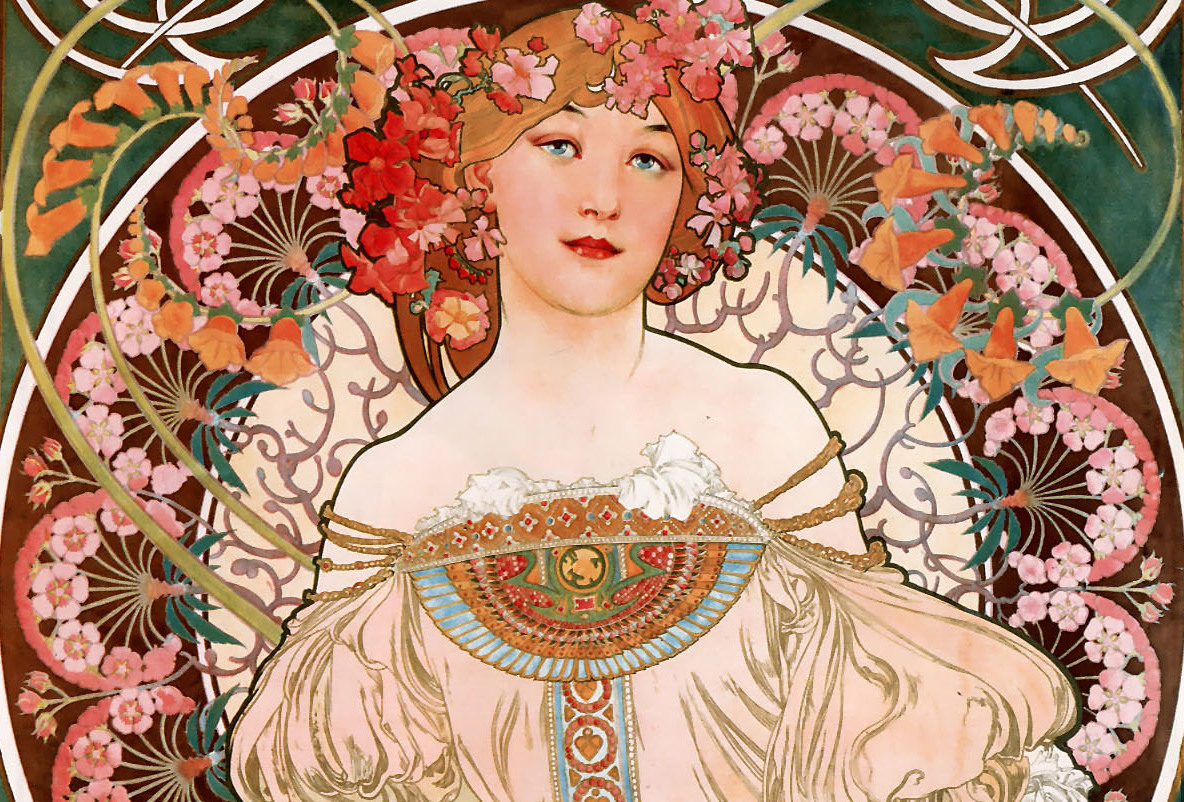At the turn of the 19th and 20th centuries, the cultural centres of Europe, including Paris and Vienna, were experiencing a boom in modern lifestyles. Art Nouveau artworks reflected the glamour of the fin de siècle atmosphere, the change in social mores, and the decadence of the bourgeois class.
Alfons Mucha – genius of Art Nouveau
Alfons Mucha, Czech painter, artist, illustrator and amateur photographer, was one of the most influential personalities of the Art Nouveau period. He used a palette of muted pastels and drew beautiful women in flowing clothes and with wind-blown hair, usually against botanical backgrounds. His works were characterised by sensual shapes, floral ornaments, and decorative elements. He was such a distinctive figure that Art Nouveau in Paris came to be known as Le Style Mucha.
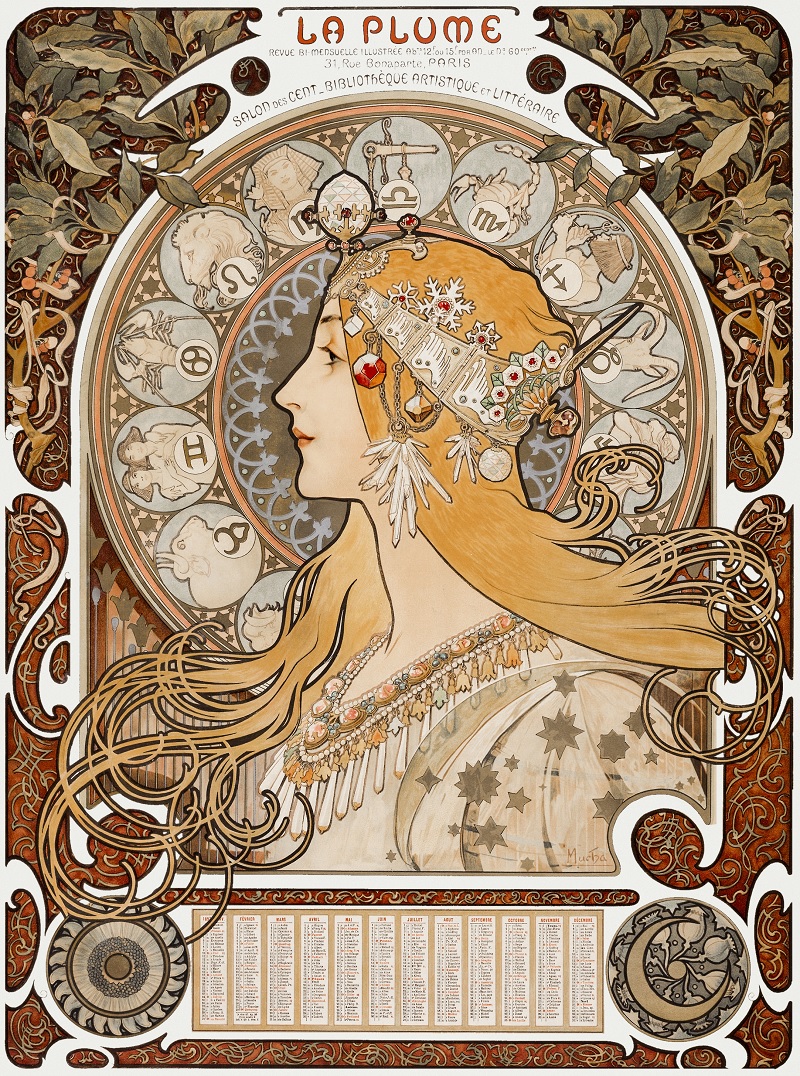 Alfons Mucha, Public domain, via Wikimedia Commons
Alfons Mucha, Public domain, via Wikimedia CommonsPainting since childhood
He was born on 24 July 1860 in today’s Ivančice into the family of a manor servant. Even as a child he was interested in painting. In 1879 he went to Vienna to work as a painter of theatre sets. In 1887 he moved to Paris to study at the Académie Julian. While in Paris, Mucha switched from painting to magazine illustration. Mucha lived and worked in Paris for nearly 20 years and created a large number of impressive works of art in commercial illustration. His work brought him his crowning achievement at the heart of the Parisian art world and appeared both on posters and products.
Art Nouveau posters
Art Nouveau posters depicted an idealised lifestyle. Consumers were therefore buying an illusion of a lifestyle rather than a specific product. The images and style of the advertising posters were also transferred to the packaging of the products – Mucha’s work addressed people, for example, from Lefèvre-Utile biscuit tins. This naturally strengthened the relationship between the product and the advertisement.
Mucha became famous for his relationship with the legendary actress Sarah Bernhardt for whom he often designed posters. It is not surprising that Sarah appeared, among other things, on the poster for Lefèvre-Utile biscuits. In the bottom left corner was a handwritten inscription that the only thing better than a Lefèvre-Utile biscuit is two Lefèvre-Utile biscuits. This was followed by Bernhardt’s signature, which is considered by most historians to be the first moment of authorised celebrity consent on a poster. Putting a famous name under a particular product was a novelty that soon spread. Celebrity endorsements simply worked as early as in Mucha’s era.
Sarah, Sarah, Sarah
It was Sarah Bernhardt who was the catalyst that launched Mucha’s astonishing career. This crucial moment came in December 1894 when Sarah – then at the height of her fame – was looking for an artist to design a new poster for Gismonda, the drama in which she was starring.
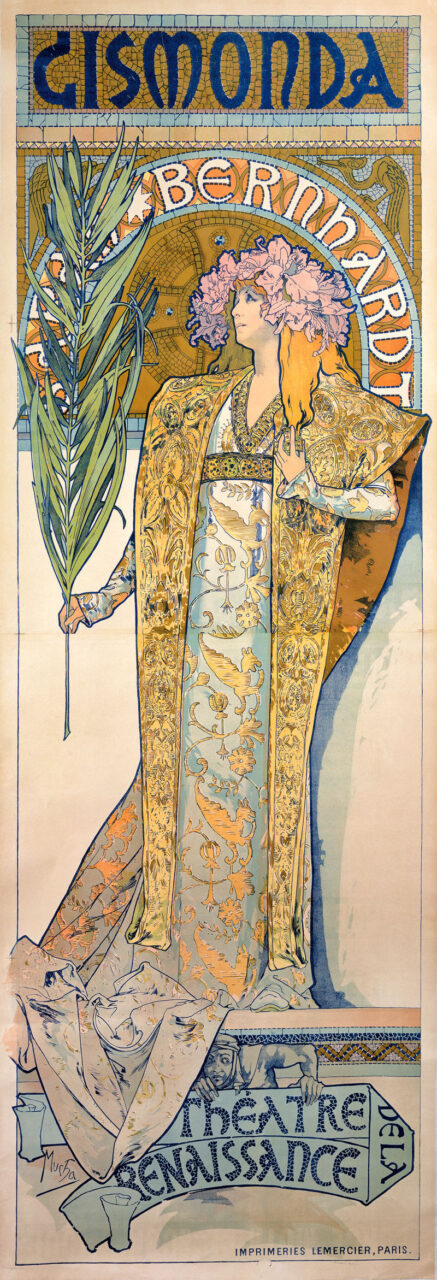 Alphonse Mucha, Public domain, via Wikimedia Commons
Alphonse Mucha, Public domain, via Wikimedia CommonsMucha created an oversized poster with romantic motifs, swirl silhouettes, and mosaic patterns. This work was distributed throughout Paris, making Mucha a well-known artist and securing him a five-year collaboration with Sarah Bernhardt.
The posters for the famous actress opened doors to the world of advertising for Mucha and literally made him a renowned designer overnight. He designed posters for JOB cigarette papers, Ruinart champagne, Lefèvre-Utile biscuits, Nestlé baby food, Idéal chocolate, Meuse beer, Moët-Chandon champagne, Trappestine brandy and Waverly and Perfect bicycles. He has even collaborated with the jewellers Fouquet.
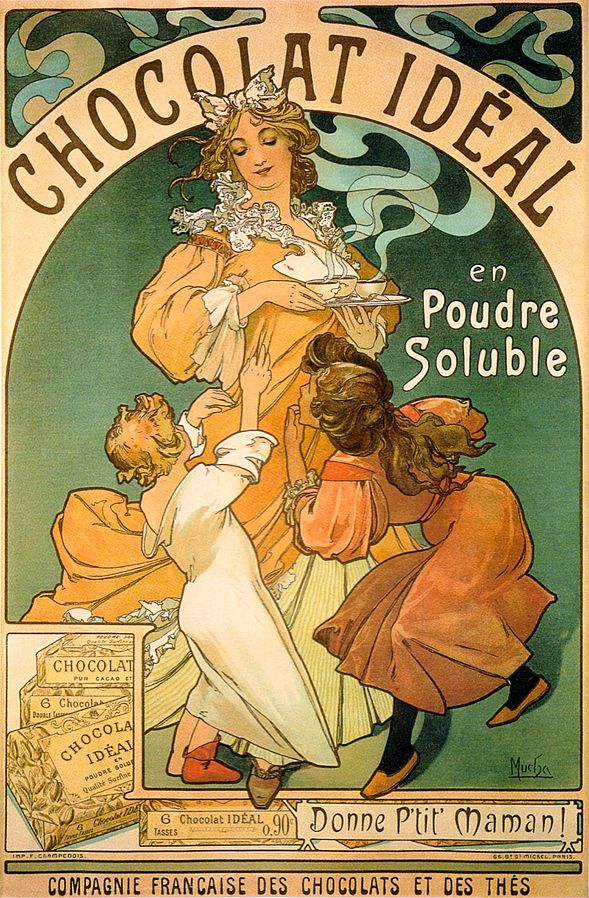 Alphonse Mucha, Public domain, via Wikimedia Commons
Alphonse Mucha, Public domain, via Wikimedia CommonsLefèvre-Utile biscuits
The Lefèvre-Utile biscuit company, based in Nantes, exclusively commissioned leading artists to promote its products. In addition to posters, Mucha also designed box lids, biscuit wrappers and other printed materials for the company.
The social environment depicted in the poster is intended to show the high status of consumers of Lefèvre-Utile products. Mucha was exceptional in his ability to elevate an object beyond its ordinary origins. In his poster, he brought the ordinary biscuit into a VIP setting. This work combines the simple biscuit with an atmosphere of high society and prestige. And this is undoubtedly an excellent concept that continues to pay off for advertising designers today.
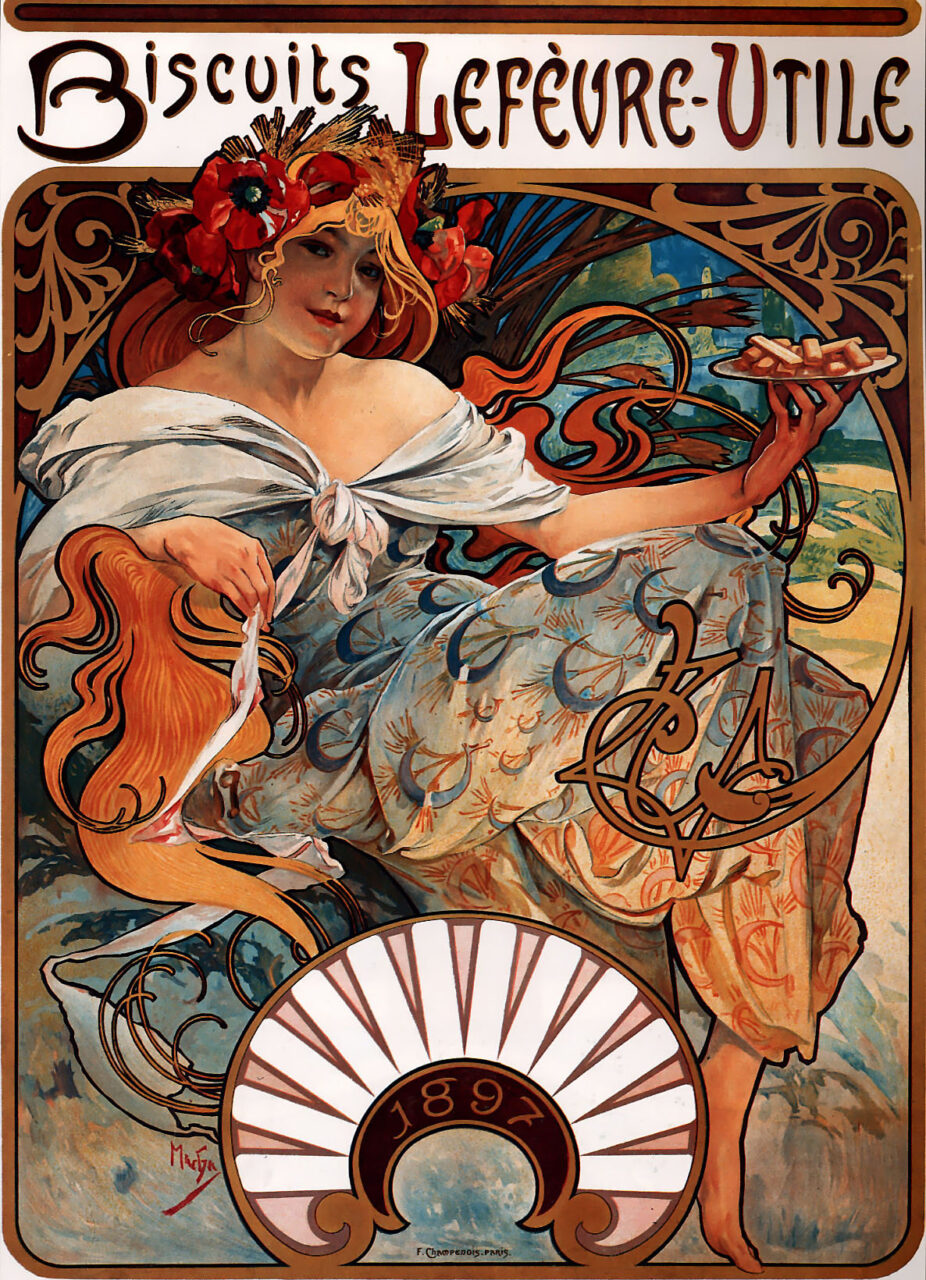 https://www.screenvoice.cz/wp-content/uploads/2024/07/Susenky-Lefevre-Utile-Alfons_Mucha_-_1896_-_Biscuits_Lefevre-Utile-1.jpeg
https://www.screenvoice.cz/wp-content/uploads/2024/07/Susenky-Lefevre-Utile-Alfons_Mucha_-_1896_-_Biscuits_Lefevre-Utile-1.jpegMoët & Chandon champagne
It was just supposed to be a poster, but it is a work of art. Contemporary posters or billboards for wine or beer with their motifs frequently including slightly off-colour jokes or half-naked women do not come out victorious in comparison with Mucha’s work. Mucha’s poster features an extremely charming woman against a white background decorated with elaborate partial images. A dark framing with the name of the winery is at the top, and the name of the wine being promoted is in the bottom rectangle.
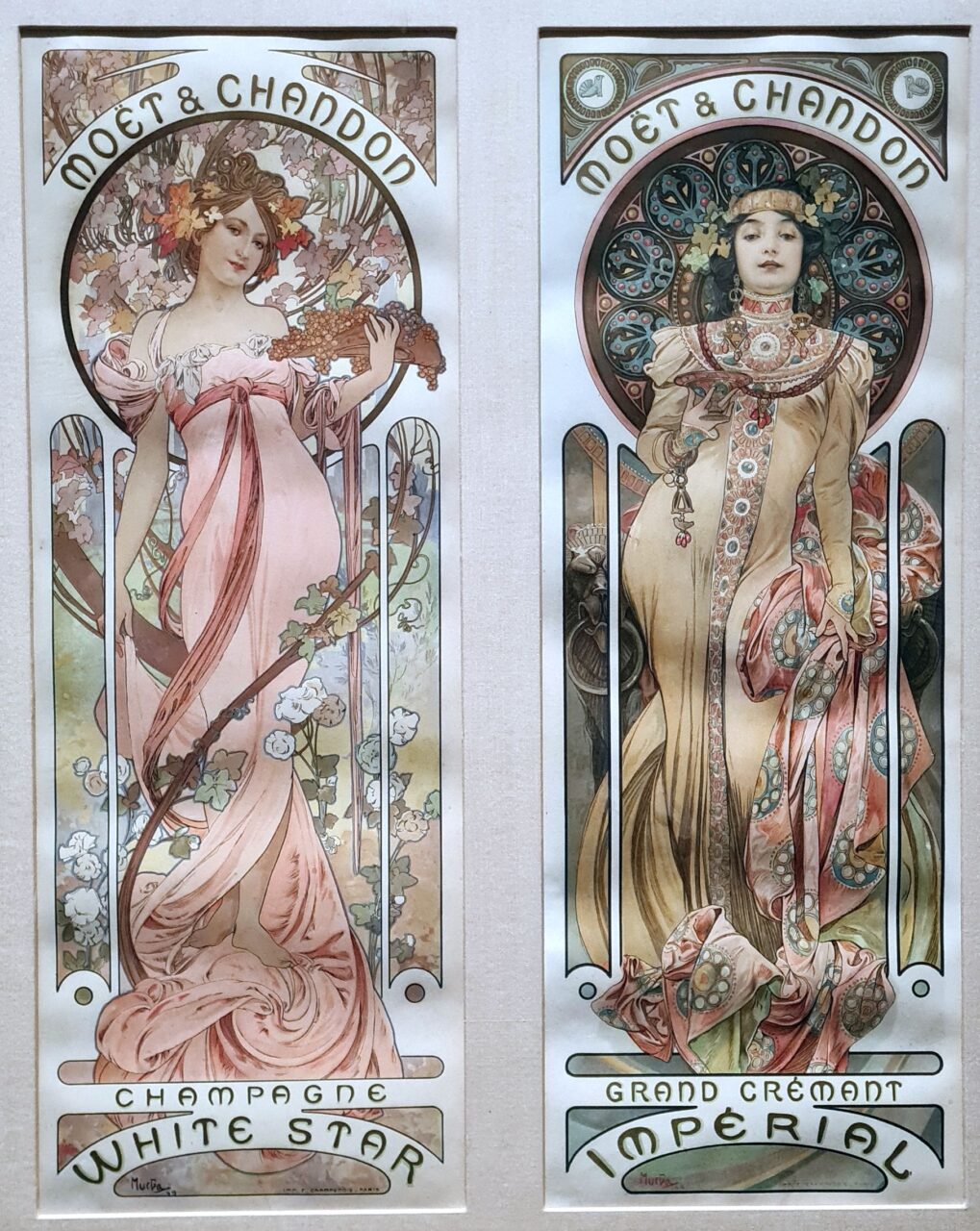 Derbrauni, CC BY 4.0, via Wikimedia Commons
Derbrauni, CC BY 4.0, via Wikimedia CommonsBicycles
Mucha’s art was a brand in itself and went far beyond the products that Mucha promoted. As such, Mucha was commissioned to design posters for two competing companies within a year. This was truly unique in the advertising world of the time. In 1898, Mucha’s posters for Cycles Perfecta and Waverley Cycles were displayed simultaneously in the streets of Paris.
Because of the obvious need to differentiate the two products, Mucha’s two cycling posters are diametrically opposed. While the poster for Cycles Perfecta looks slightly extravagant, the poster for Waverley Cycles has an unusual landscape format and is more allegorical and elegant. For this sturdy American-made bicycle, Mucha didn’t even try to show the whole bike. Instead, he made it symbolic by having a determined-looking young woman leaning on an anvil. In her hand is a sprig of laurel, presumably to signify the accolades the product has received.
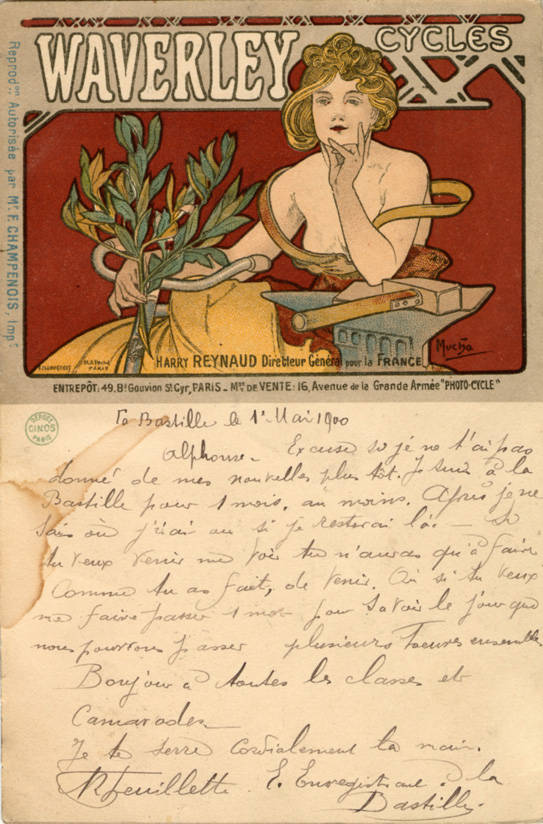 Public domain, via Wikimedia Commons
Public domain, via Wikimedia CommonsPilsner Urquell TV advertising today
Many artists and manufacturers draw inspiration from Mucha’s works even today. Although Mucha did not experience much fame in Czechia in his time, he is now famous and admired in our country. He is often exhibited and imitated and is still a subject of interest to people and the media.
It is not surprising that he has not escaped television advertising. A Pilsner Urquell advert featuring Alfons Mucha appeared on television screens in 2009. The story takes place between 1910 and 1928 at the castle in Zbiroh. Alfons Mucha, at that time already a very successful and renowned painter, found his true fortune there and in 18 years created his magnificent work, The Slav Epic, a monumental cycle of twenty large-scale paintings depicting moments in the history of the Slavic peoples.
Video: Pilsner Urquell - Alfons Mucha
“We are very pleased that we have once again managed to make a telling advertisement featuring another prominent figure from our history. We chose Alfons Mucha because he is one of our most important artists and his works have achieved worldwide fame...,”
said Karel Kraus, Pilsner Urquell brand manager, commenting on the ad.
The idea of Leo Burnett, the advertising agency that delivered the spot, definitely worked. It is not very likely that Alfons Mucha’s Slav Epic was made in this way, but it is not impossible. Be it as it may, Mucha would certainly have liked Pilsner beer.

